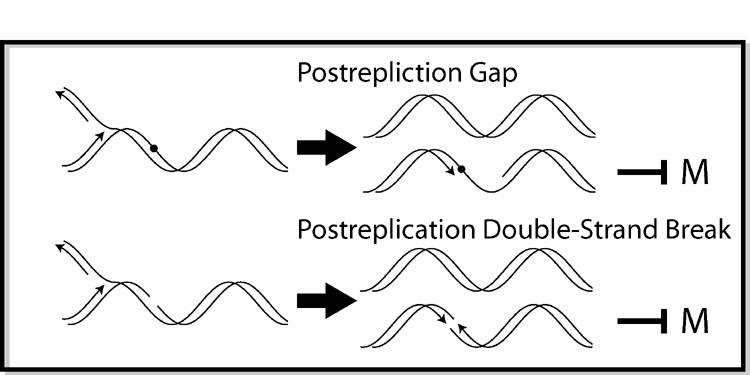
Postreplication checkpoint
Encyclopedia
Postreplication checkpoint
When the genomic DNA of eukaryotic cells becomes damaged by spontaneous processes, chemical mutagens, or sunlight exposure, the replication of damaged DNA triggers a cellular response called a postreplication checkpoint. This response prevents cell cycleCell cycle
The cell cycle, or cell-division cycle, is the series of events that takes place in a cell leading to its division and duplication . In cells without a nucleus , the cell cycle occurs via a process termed binary fission...
progression until postreplication repair
Postreplication repair
Postreplication repair is the repair of damage to the DNA that takes place after replication.Some example genes in humans include:* BRCA2 and BRCA1* BLM* NBS1DNA damage prevents the normal enzymatic synthesis of DNA by the replication fork...
processes are completed, and may control the activity of these DNA repair pathways. In cell types that execute S phase
S phase
S-phase is the part of the cell cycle in which DNA is replicated, occurring between G1 phase and G2 phase. Precise and accurate DNA replication is necessary to prevent genetic abnormalities which often lead to cell death or disease. Due to the importance, the regulatory pathways that govern this...
before mitosis
Mitosis
Mitosis is the process by which a eukaryotic cell separates the chromosomes in its cell nucleus into two identical sets, in two separate nuclei. It is generally followed immediately by cytokinesis, which divides the nuclei, cytoplasm, organelles and cell membrane into two cells containing roughly...
, such as fission yeast and human cells, the postreplication checkpoint makes time for repair by delaying the onset of mitosis. In cell types where mitosis and S phase are concurrent, such as budding yeast, the postreplication checkpoint delays the progress of mitosis at metaphase.
The chk1 gene is required to mediate the postreplication checkpoint and is conserved in yeast and humans. Fission yeast cells in which the chk1 gene has been disrupted progress normally through the cell cycle after exposure to UV radiation until they have carried damaged DNA through S-phase and the subsequent mitosis, at which point cells begin to die and exhibit gross chromosomal damage. The BRCA1 tumor suppressor plays a role in the activation of human chk1, therefore the postreplication checkpoint may prevent the genetic changes that lead to cancer.
The signal for activation
A number of genes required for the postreplication checkpoint encode proteins that recognize single-stranded DNA and the 5' end of transitions between single-stranded DNA and double-stranded DNA. These structure are known to be generated in two different ways during S phase. The replication of DNA containing damaged bases leaves gaps in the newly-synthesized DNA strand, and the replication of nicked or gapped DNA creates double-strand breaks. Both structures are thought to activate the postreplication checkpoint.

